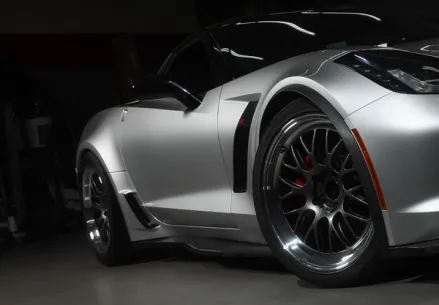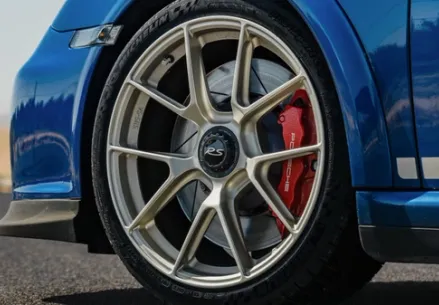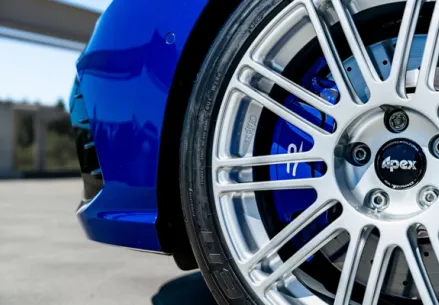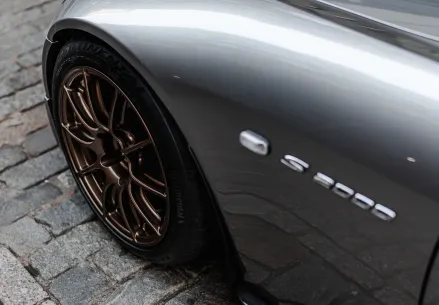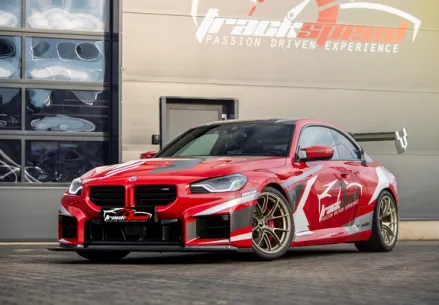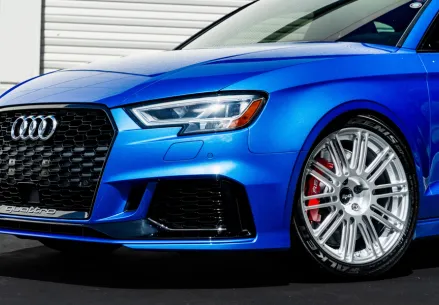
What is Negative Camber? Exploring the Positives of Negative Camber
Article | 04/14/2025 by Brandon Kimbell
Updated on 04/14/2025
Article Breakdown:
- In this article, we answer the question: What is negative camber? We explain what camber is and how it affects your car’s performance, and why negative camber is a good thing for track cars.
- We explain how to dial-in the optimal amount of camber for your needs and explain what hardware is required to do so.
Dialing-in a car’s setup for optimal performance driving is often a complex balancing act that requires both careful selection of aftermarket parts and an understanding of how to adjust those parts for the desired feel. One of the most important factors that affects a car’s handling – especially in a high-performance context – is camber. It’s a word that’s used in a lot of varied circles of car culture and used often, and that’s because camber doesn’t just impact a car’s performance, but also plays a role in how a car sits and looks. That means camber is just as important to track rats trying to shave down lap times as it is to the stance crowd trying to shave down ride heights. So if you’re still asking yourself “What exactly is camber and why does it matter?” This article will demystify things, explain the relationship between performance driving and camber, and explore how dialing-in either positive, negative, or neutral camber will affect your car’s performance. First things first, let’s define camber:
Camber (kambər): The angle of a tire relative to the driving surface.
Simple, right? Camber is just how a tire sits on the road. Negative camber angles the tire inward towards the car, neutral camber has it sitting straight up-and-down, and positive camber angles the tire outward. While other factors come into play when dialing-in a chassis setup, including toe and caster, understanding camber and the role it plays is the best place to start.
The photo below depicts how camber works. The tire sits perpendicular with the road with zero or neutral camber dialed-in. When negative camber is dialed-in, the tire leans inwards towards the centerline of the vehicle. When positive camber is dialed-in, the tire is tilted away from the centerline of the vehicle.

We consult many Apex customers who want to maximize the performance of their track car, but may be new to performance driving and its jargon. What we’ve found through those conversations is there’s often an assumption that negative camber is an exclusively bad thing for a car’s handling performance. There’s a general misunderstanding of the role it plays in dialing-in a car’s setup because they associate negative camber with “stanced” fitments, and while dialing-in extreme amounts of negative camber is a way to squeeze fitments with ridiculously wide wheels and stretched tires under a car’s fender for a “hellaflush” fitment, dialing-in more moderate amounts of negative camber is an important part of performance driving setups. Ultra-flush, stanced fitments that rely on extreme amounts of negative camber to stuff wide wheels under a fender are purely aesthetic fitments, and, unsurprisingly, rob a car of handling performance. However, negative camber is foundationally important to achieving tire bite, a key part of any performance chassis setup.

An example of a “stanced” fitment using extreme negative camber
There’s a good reason cars come from the factory with neutral alignments that have very little negative or positive camber. Being that most road cars are used for commuting and errands, a neutral alignment with minimal camber promotes tire longevity and also provides the car with stable and predictable handling. When a tire makes contact with the road surface, it creates a contact patch, which is where grip is generated. A car setup with neutral camber will generate the largest contact patch while being driven in a straight line or while taking corners slowly, the way you’re expected to drive on public roads. However, performance drivers rarely spend much time driving in a straight line, and your tire’s contact patch needs to be more dynamic when hustling around corners.
Whether you enjoy spirited canyon or backroad driving or you’re fighting for position on-track in a competitive race environment, grip is everything for performance driving – and especially important when attacking corners. When a car is thrown into a corner at speed, it experiences lateral Gs. This results in the outer tires gaining positive camber. In other words, the outer tires roll over to the shoulders, which reduces their contact patch and results in less grip when you need it the most.

An E92 track car utilizes moderate negative camber while cornering aggressively
It is important to note that various suspension designs operate and react differently under compression/when being driven hard. To keep things concise, this article will focus specifically on the relationship between camber and the common MacPherson strut design that’s found on most road-going vehicles. Notably, the MacPherson strut does not gain much negative camber upon compression, so you must dial-in what’s called static negative camber or camber dialed-in on a flat surface while the car is stationary. This is to compensate for the heavy G-forces the suspension endures during hard cornering. When the car has the appropriate amount of static negative camber dialed-in, the outside tires will come close to zeroing out when it dives into a corner, which will ideally maintain low levels of negative camber and maximize the tires’ contact patch through the corner. This gives you grip where and when you need it most, and builds a driver’s ability to confidently maintain higher speeds throughout the race circuit.
How much camber is enough?
Unfortunately there is no uniform answer to this and the ideal amount of camber is going to be different for every driver, platform, suspension setup, and application. It’s a lot like asking a tailor to size you for a business suit that you’re going to do kung fu in from a low resolution photograph. Consulting an expert is the best place to start, whether that’s a driving coach, the fastest guys at your local trackday, or an Apex product specialist. Different tire compounds, suspension types, driving styles, and your overall goal for their car all play a role in defining how much camber you’re going to want to dial-in. In fact, in the competitive levels of motorsport, suspension setups become incredibly technical – to the point that variables like track location, local weather conditions, and a course’s layout all have a major impact on how engineers set up a race car’s suspension and alignment. That means the pros dial-in a unique setup to be competitive at each different event they compete in.
That said, there are some baseline specifications that hobbyists can use as a starting point to dial-in from. Kind of like buying an off-the-rack suit in your size and having it tailored for the perfect fit. There are also benchmark negative camber specifications that people have established based on tire compounds and the car’s planned usage as a dual-duty car that sees street time and track time will have a less aggressive setup than a full-time track machine. Additionally, if you are looking to install a particularly wide wheel and tire combination respective to a particular chassis, you may need a specific amount of negative to create more clearance between the top of the tire and the edges of the front fenders, which will also influence your camber specifications.
Again, the ideal process is consulting a professional about your specific needs and car. However, the following camber specifications can be used loosely a benchmark starting points:
| Driving Type | Front Camber | Rear Camber |
|---|---|---|
| Spirited daily driver/occasional track car | -1.5° to -2.0° | -1.8° |
| Frequent track day warrior | -2.5° to -3.0° | -1.8° |
| Dedicated track car | -3.2° to -3.8° | -2.2° |
Our library of vehicle-specific fitment guides and our vehicle configurators are a great way to explore the options for your needs if you’re unsure of how aggressive or how street-focused you’d like your car to be.
How can I dial in negative camber?
Unfortunately, dialing-in camber is not something you can do properly with basic home garage setups. You’ll need more than a jack stand and a hammer.
Most cars do not come with adjustable front suspension components from the factory, so many platforms are going to need additional parts called camber plates to adjust their camber. There are two types of camber plates: A fixed plate and an adjustable plate. As the names imply, fixed camber plates offer a predetermined fixed amount of negative camber, while adjustable camber plates offer a wider range of adjustments ranging from the mild camber you’ll want on a street car to extreme camber that you probably shouldn’t be running on the street. If you’re unsure of whether fixed or adjustable camber plates are right for you, contact an Apex product specialist and we’ll be happy to discuss your options. Aftermarket adjustable camber plates will typically set you back around $300-500 depending on the brand and your application, while fixed plates are typically a bit cheaper. While this is indeed another aftermarket part that will rob from your kid’s college fund, it is important to note that the initial fixed cost and achieved benefits significantly outweigh the costs of burning up expensive track tires every weekend because you don’t have your camber dialed-in correctly. Some chassis are indeed harder on tires than others, but attending any high performance driving event (HPDE) or autocross event without some negative camber dialed-in will quickly result in premature tire wear. More specifically, the outer shoulders of the tires will take an absolute beating corner-after-corner, and oftentimes turn a shade of blue due to the extreme levels of heat that friction creates. That’s all to say camber plates quickly pay for themselves if you’re going to be tracking the car at all.
Generally speaking, the rear of a car does not require nearly as much negative camber as the front. Although that’s all chassis dependent, you will find that most cars come stock with suspension components in the rear that allow an alignment technician to dial-in a reasonable amount of negative camber, so aftermarket camber arms are rarely required. Most vehicles will offer up just north of two degrees of negative camber at the rear, and that is typically enough of a range to suit most enthusiasts’ needs. If more adjustability is desired, you will have to purchase and install aftermarket rear camber arms.

Listen to Your Tires
Now that you understand the basics of camber and how to dial it into your setup, let’s talk about tuning. Checking your tire wear patterns frequently will help you understand a lot about your driving style and guide you on how to adjust your camber settings to improve performance. Beyond the wear patterns, checking on your tire temperatures promptly after you have exited the race track with a tire pyrometer can also be indicative of what adjustments need to be made. Keeping a logbook in the paddock and noting those wear patterns and post-race temperatures and compiling them over the course of a season will help you see what’s working and what isn’t. Keep in mind that there are a lot of other variables that can affect tire wear, like your driving style evolving as you gain more experience, new modifications to the car, different track locations, etc. However, if the shoulders of your tires are wearing significantly in relation to the rest of the tire and have higher temperature readings post-race than the rest of the tire, you most likely need to add more negative camber to the mix. If the inside of the tire tread is wearing and giving off higher temperature readings, you have too much camber dialed-in. A nice, even wear pattern and relatively consistent tire temperatures are the ultimate goal.

At the end of the day, camber settings have a dramatic impact on increasing mechanical grip and promoting consistent tire wear, and remain one of the most influential factors when dialing-in a car that performs well. The right amount of negative camber for your specific needs will provide you with more confidence behind the wheel. The only thing left to do is to get out, start logging some seat time, and find what works best for you!
Tags
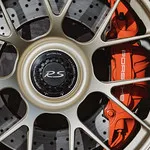 Brandon Kimbell
Brandon KimbellBrandon is a Porsche Fitment Expert at APEX Wheels. Prior to joining APEX in 2022, he worked as Office Manager for a Porsche & Ferrari service and race shop, guiding customers in all areas – suspension, power, aesthetics, you-name-it. His first foray into racing came In college when he was asked to assist at a PCA club race. Says Brandon, “I figured if I am already making the drive, I might as well enter the HPDE happening at the same time.” He hasn't stopped since. Among the various cars he has owned and/or tracked are a ‘74 Corvette Convertible, ’74 Firebird Formula 400, ‘17 GTI, ‘07 Cayman S, and his current ride, a ‘12 Cayman R (BGB X51 pack 3.8L) with staggered APEX EC-7RS 18x9”ET46 & 18x10” ET36 in Motorsport Gold. Fun Fact: Brandon is a big fan of SIM racing, which he uses to learn about a new track he’s going to or get a refresher on a familiar track, as well as improve his racecraft.Have questions about wheels for your Porsche? Use our contact form and ask for Brandon.
If you like cheap gear you will hate this newsletter.
